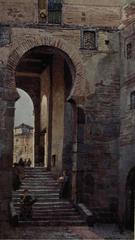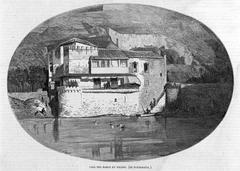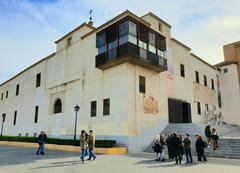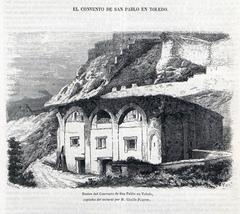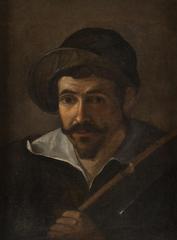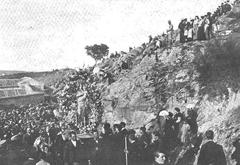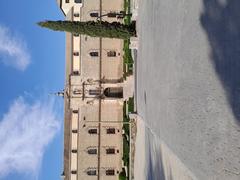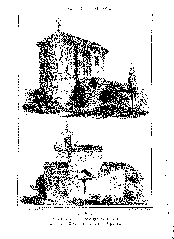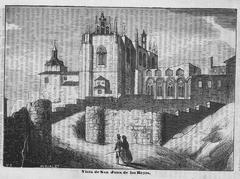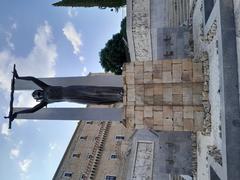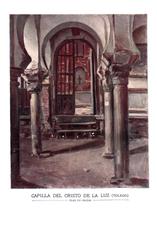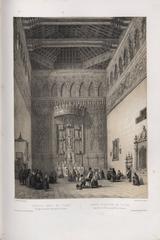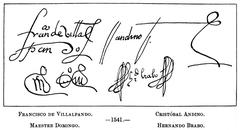
Puerta Nueva de Bisagra: Visiting Hours, Tickets, and Historical Significance in Toledo
Date: 04/07/2025
Introduction
The Puerta Nueva de Bisagra, marking the northern gateway to Toledo, Spain, is a monumental structure steeped in over a thousand years of history. Originally constructed during the Moorish era in the 10th century as “Bab al-Saqra,” or the “Gate of the Sagra,” it has evolved from a defensive stronghold into a Renaissance masterpiece, reflecting Toledo’s unique blend of Christian, Islamic, and Jewish heritage (Spotting History; Spain.info; Trip101).
More than just an architectural marvel, Puerta Nueva de Bisagra has served as a customs checkpoint, a ceremonial entrance for royalty, and a symbol of Toledo’s status as a political and cultural crossroads. Today, it stands as a National Monument and a must-visit site, free and open to the public, offering panoramic views and a gateway into the city’s vibrant past (Lonely Planet; Toledo Spain Tourism).
This guide provides a comprehensive overview of the Puerta Nueva de Bisagra’s history, architectural highlights, visiting information, and tips for making the most of your visit to one of Toledo’s most iconic historical sites (Trip101; Touristear).
Historical Overview
Moorish Origins and Medieval Function
The Puerta Nueva de Bisagra’s earliest form dates to the 10th century, built under Moorish rule as “Bab al-Saqra” (Spotting History). This gate played a dual role—defending the city and controlling trade, as merchants entering Toledo from the plains were subject to taxes (Historias de Toledo). Remnants of the original Moorish gate can still be seen in the nearby Puerta Antigua de Bisagra (also known as Puerta de Alfonso VI), featuring horseshoe arches and geometric patterns typical of Islamic architecture (Spotting History).
Renaissance Transformation
By the 16th century, the gate had fallen into disrepair. Under Charles V, Holy Roman Emperor, a grand reconstruction began in 1540, led by Alonso de Covarrubias and other prominent architects (Wikipedia ES; Spain.info). Completed in 1576, the new design transformed the gate into a Renaissance triumphal arch, blending classical symmetry with defensive strength. It consists of an outer defensive body with two massive cylindrical towers and an inner ceremonial arch flanked by square towers, all richly adorned with imperial and city coats of arms (Puerta Nueva de Bisagra; Lonely Planet).
Key Architectural Features
- Outer Facade: Two imposing round towers, a grand semicircular arch, and Charles V’s imperial coat of arms (Spain.info).
- Inner Facade: Two square towers and a semicircular arch displaying the city’s coat of arms.
- Patio de Armas: The central courtyard, formerly for military gatherings, now features statues of Charles V (Puerta Nueva de Bisagra).
- Decorative Motifs: Renaissance pilasters, classical entablatures, and Mudejar (Islamic-influenced) ornamentation (Meticulous Meanderings).
Cultural and Symbolic Importance
The Puerta Nueva de Bisagra is emblematic of Toledo’s identity as a crossroads of cultures. It symbolizes the city’s transformation from Moorish stronghold to Christian imperial capital, and its grandeur was designed to impress visitors and dignitaries (Historias de Toledo). Its roles have included:
- Defensive Stronghold: Integral to city fortifications.
- Customs Post: Site for tax collection on incoming goods (Puerta Nueva de Bisagra).
- Ceremonial Entrance: Venue for royal and civic processions, reinforcing Toledo’s status (Lonely Planet).
The juxtaposition of Renaissance and Moorish architectural elements is a physical testament to Toledo’s multi-religious and multicultural history (Atlas Obscura).
Urban and Political Context
Medieval to Early Modern Periods
The gate’s strategic location made it the principal northern entrance to Toledo. After the Reconquista in 1085, it became even more vital as the city assumed greater administrative and religious roles in Castile (Meticulous Meanderings). The Renaissance reconstruction was part of a citywide effort to modernize and beautify Toledo during its era as an imperial capital (Historias de Toledo).
Modern Era
Though defensive needs waned, the gate remained central to civic life. Designated a National Monument in the 20th century, it has since been carefully preserved (Meticulous Meanderings). Today, it is closed to vehicles but easily accessible to pedestrians, offering sweeping views and a tangible connection to the past (Puerta Nueva de Bisagra).
Visitor Information: Hours, Tickets, and Accessibility
- Opening Hours: As an outdoor monument, Puerta Nueva de Bisagra is accessible 24/7, though it’s best visited during daylight (usually 9:00 AM–7:00 PM for optimal safety and photos) (Trip101).
- Admission: Free of charge. Guided tours that include the gate may have a fee.
- Accessibility: The plaza is pedestrian-friendly, but some uneven terrain and steps may limit access for wheelchairs or those with mobility challenges (Toledo Spain Tourism).
- Guided Tours: Available through local operators, often including other key sites for a deeper historical context.
- Getting There: Located at the northern entrance to Toledo’s historic center, close to the main bus station and public parking.
Nearby Attractions and Travel Tips
- Alcázar of Toledo: A fortress and museum, just a short walk away.
- Toledo Cathedral: A Gothic masterpiece in the city center.
- Jewish Quarter: Winding medieval streets with synagogues and artisan shops.
- Plaza de Zocodover: The main square, central to city life (Wanderlog).
- Photography: Best shots are from the exterior plaza, especially at sunrise or sunset when the stone glows warmly.
Recommended Seasons
Spring (April–June) and autumn (September–November) offer pleasant weather and lighter crowds (Touristear).
Preservation and Legacy
Declared a National Monument, Puerta Nueva de Bisagra has undergone various restoration efforts to preserve its structural and artistic integrity (Cultura Castilla-La Mancha). Its continued presence highlights Toledo’s legacy as a city shaped by cultural fusion and historical resilience (Spain.info).
Frequently Asked Questions (FAQ)
Q: What are the opening hours?
A: Puerta Nueva de Bisagra is open at all hours as an outdoor monument, but daylight visits are recommended.
Q: Is there an entrance fee?
A: No, entry is free.
Q: Are guided tours available?
A: Yes, many walking tours include the gate and provide historical context.
Q: Is it accessible for wheelchairs?
A: Access may be limited due to uneven surfaces and steps.
Q: What are the best nearby sites?
A: Alcázar of Toledo, Toledo Cathedral, the Jewish Quarter, and Plaza de Zocodover.
Plan Your Visit
Include Puerta Nueva de Bisagra on your Toledo itinerary for a firsthand experience of the city’s monumental gateway and multicultural past. For guided experiences and personalized itineraries, consider using the Audiala app.
Discover More:
Alt text: Puerta Nueva de Bisagra with its imposing Renaissance towers and arches under a clear blue sky.
For a virtual experience, visit: View a virtual tour of Puerta Nueva de Bisagra.
References
- Spotting History
- Spain.info
- Meticulous Meanderings
- Trip101
- Historias de Toledo
- Lonely Planet
- Toledo Spain Tourism
- Atlas Obscura
- Toledo City Council
- Touristear
- Cultura Castilla-La Mancha
- Wanderlog



